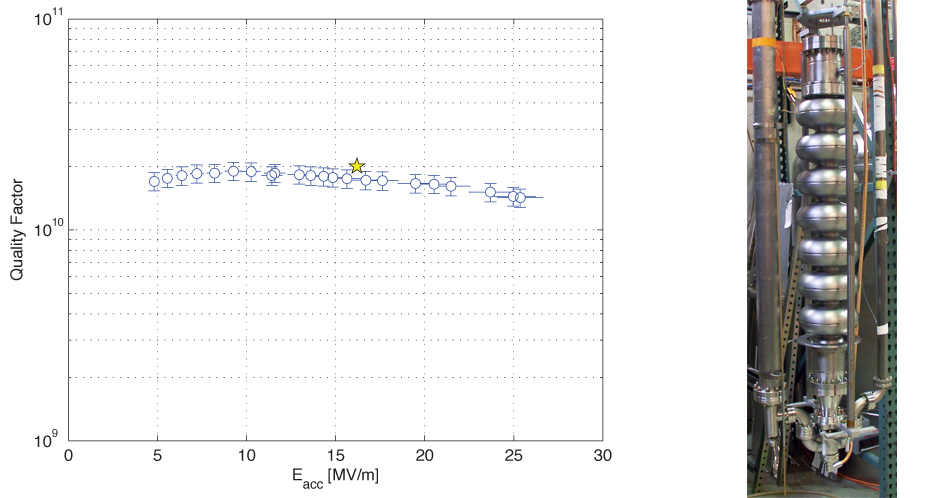X-RAY RUNS: Apply for Beamtime
2017 Nov 1 - Dec 21
2018 Feb 7 - Apr 3
2018 Proposal/BTR deadline: 12/1/17
2018 Apr 11 - Jun 4
2018 Proposal/BTR deadline: 2/1/18

At left:
Plot of Quality Factor versus Accelerating Gradient at 1.8 K. The star marks the ERL main linac quality factor and accelerating gradient design specification. At right: Cornell's 7-cell superconducting RF cavity.
(click on image for larger view)
Cornell has reached performance specifications for the ERL's main-linac cavities in a vertical test. This cavity has been completely designed, constructed, and tested in Cornell's SRF group. The cavity shape has been optimized to allow 200mA in the ERL linac, even with realistic construction errors. Starting with bare niobium sheets, the SRF team constructed this cavity from scratch, carefully controlling dimensions along the way. This led to a field flatness of 85% without tuning, an exceedingly high number indicating exceptional production accuracy. Chemical cleaning has also been performed in house.
This first ERL-main-linac cavity has now been tested at operation temperature and operation field levels where it achieved the required quality factor Q of about 2x1010. While reaching this performance specification already with the first prototype in a vertical test is a promising achievement, it will now have to be shown that this quality factor can be maintained in horizontal tests after the cavity has been equipped with its helium vessel, RF couplers and HOM absorbers. A horizontal test is already being developed and is planned for early 2012.
Increased quality factors go along with decreased energy consumption of an SRF linac, particularly if it accelerates continuous beams. The achievement of high Q is therefore relevant not only to Cornell's ERL but also to Project-X at Fermilab, to the Next Generation Light Source, to Electron-Ion colliders, spalation-neutron sources, and accelerator-driven nuclear reactors.
The ERL's specifications for accelerating gradient of 16MV/m with a Q of 2x1010 at a temperature of 1.8K were achieved and an extended parameter range was explored: gradients to 25MV/m without significant field emission, Qs of nearly 3x1010, and temperatures down to 1.6K.
more SRF News here:
http://www.lepp.cornell.edu/Research/AP/SRF/WebHome.html
